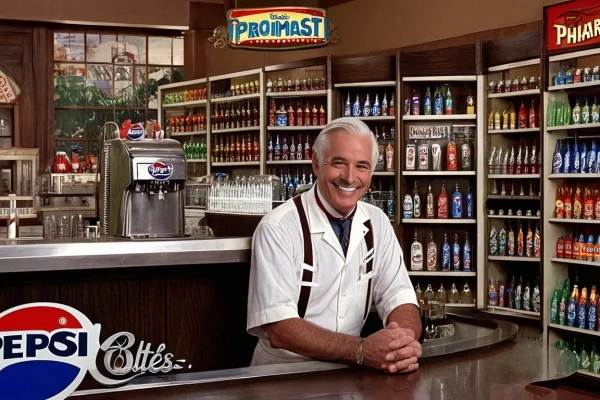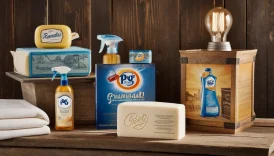Who Inspired the Birth of Pepsi?

- Who Inspired the Birth of Pepsi?
- The Visionary Behind Pepsi
- The Role of the Original Recipe
- The Influence of Health Trends
- The Connection to Coca-Cola
- The Evolution of Branding
- The Impact of Marketing Strategies
- Pepsi's Cultural Significance
- Pepsi in Popular Media
- Global Expansion and Adaptation
- Frequently Asked Questions
Have you ever wondered how a simple drink transformed into a global phenomenon? The story of Pepsi is not just about a soft drink; it’s about vision, innovation, and a touch of competition. The birth of Pepsi can be traced back to a man named Caleb Bradham, a pharmacist who had a dream to create a refreshing beverage that would quench thirst and promote health. This article delves into the key figures and events that paved the way for Pepsi’s creation, showcasing the remarkable journey of this iconic brand.
Caleb Bradham was not just any pharmacist; he was a true innovator. In the late 19th century, while working in his drugstore in New Bern, North Carolina, he concocted a drink that combined sugar, vanilla, rare oils, and kola nuts. This unique blend, which he initially named Brad’s Drink, would later evolve into what we know today as Pepsi. Bradham’s vision was clear: he wanted to create a beverage that was not only delicious but also beneficial to health.
The original recipe for Pepsi was groundbreaking for its time. By mixing various ingredients, Bradham aimed to create a drink that would invigorate and aid digestion. The success of this recipe can be attributed to the growing health trends of the late 1800s, where people were increasingly conscious about what they consumed. In fact, the drink was marketed as a digestive aid, which significantly contributed to its early popularity.
Health was a major concern during Bradham’s era, and many beverages were marketed with health benefits. The original formulation of Pepsi was positioned as a refreshing tonic that could energize consumers. This approach resonated with the public, who were eager for alternatives to alcoholic beverages and sugary sodas.
Interestingly, Pepsi’s inception was also a strategic response to the rising popularity of Coca-Cola. Bradham recognized the need to create a competitive product that could capture the attention of soda drinkers. This rivalry would shape the soft drink industry for decades to come.
As the brand evolved from Brad’s Drink to Pepsi-Cola, significant rebranding efforts were undertaken. These changes helped to establish Pepsi’s identity, making it appealing to a broader audience. Today, Pepsi is recognized not only for its taste but also for its vibrant branding and marketing strategies.
Pepsi’s innovative marketing strategies, including celebrity endorsements and memorable advertising campaigns, played a crucial role in its growth. By aligning the brand with popular culture, Pepsi became a household name, capturing the hearts of consumers worldwide.
Over the years, Pepsi has transcended its role as a mere beverage; it has woven itself into the fabric of popular culture. From music to fashion, Pepsi has influenced social movements and trends, solidifying its status as a cultural icon.
With iconic commercials and product placements in films, Pepsi’s presence in popular media has further enhanced its cultural significance. The brand’s ability to adapt and resonate with different generations speaks volumes about its enduring appeal.
Pepsi’s journey from a local drink to a global brand involved adapting its marketing and product offerings to diverse cultures. This flexibility has allowed Pepsi to thrive in various markets, catering to unique consumer preferences around the world.
The Visionary Behind Pepsi
When you think of Pepsi, it’s easy to overlook the brilliant mind that sparked its creation. Enter Caleb Bradham, a pharmacist whose passion for concocting refreshing beverages led to the birth of one of the world’s most recognized brands. Born in 1867 in North Carolina, Bradham was not just a pharmacist; he was a visionary who believed in the power of a good drink to uplift spirits and promote health.
In the late 19th century, the beverage industry was ripe for innovation. Bradham saw an opportunity to create something unique that would not only quench thirst but also offer health benefits. His original formula, famously known as Brad’s Drink, was a delightful blend of sugar, vanilla, rare oils, and kola nuts. This combination was revolutionary, setting it apart from the sugary sodas that dominated the market at the time.
| Ingredient | Purpose |
|---|---|
| Sugar | Sweetness and energy |
| Vanilla | Flavor enhancement |
| Rare Oils | Unique taste profile |
| Kola Nuts | Caffeine source |
Bradham’s motivation was deeply rooted in the health trends of his time. He aimed to create a drink that would not only be enjoyable but also aid in digestion—a common concern among consumers. This innovative approach resonated with many, making his creation a hit. But it wasn’t just about the drink; it was about capturing the essence of refreshment in a bottle.
Interestingly, Bradham’s efforts were also a direct response to the soaring popularity of Coca-Cola. He recognized the growing demand for carbonated beverages and aimed to carve out his niche in this competitive landscape. His determination to create a formidable competitor led to the evolution of his brand from Brad’s Drink to Pepsi-Cola, a name that would soon become synonymous with refreshment.
In conclusion, Caleb Bradham’s vision and innovative spirit were instrumental in the creation of Pepsi. His ability to blend health with refreshment not only laid the foundation for a beloved beverage but also inspired generations of marketers and entrepreneurs. As we sip on our Pepsi, let’s remember the man who turned a simple idea into a global phenomenon.
The Role of the Original Recipe
The original recipe for Pepsi, famously known as Brad’s Drink, was more than just a concoction of ingredients; it was a vision that aimed to quench thirst and invigorate the senses. Created by Caleb Bradham in the late 1890s, this unique blend combined sugar, vanilla, rare oils, and kola nuts, setting it apart from other beverages of the time. The ingredients were carefully chosen, not only for their flavor but also for their perceived health benefits, which were a significant draw during an era obsessed with wellness.
Bradham’s approach was revolutionary. He believed that a drink could be both delicious and beneficial, a concept that resonated with health-conscious consumers of that period. In fact, the original recipe was designed with the intention of promoting digestive health, a trend that was gaining traction in the late 19th century. This focus on health is evident in the ingredients, as each component was selected for its unique properties:
| Ingredient | Purpose |
|---|---|
| Sugar | Sweetness and energy boost |
| Vanilla | Flavor enhancement |
| Rare oils | Unique taste profile |
| Kola nuts | Caffeine source for stimulation |
This original recipe not only laid the foundation for what would become a global sensation but also highlighted how innovation in beverage formulation could challenge the status quo. Bradham’s creation was not merely a response to the growing soda market; it was a proactive attempt to carve out a niche that appealed to both the taste buds and the health-conscious mindset of consumers.
Interestingly, the recipe’s evolution over time reflects the shifting preferences of the public. As Pepsi grew in popularity, the brand adapted its formula to meet the demands of an expanding audience. This adaptability has been crucial in maintaining its relevance in a competitive market. So, next time you take a sip of Pepsi, remember that you’re enjoying a drink that has a rich history rooted in innovation, health consciousness, and a bit of daring spirit!
Brad’s Drink,
This article explores the origins of Pepsi, focusing on the key figures and events that led to its creation, as well as the brand’s evolution over time.
Caleb Bradham, a pharmacist, was the driving force behind the creation of Pepsi. His innovative approach to beverages laid the groundwork for what would become a global brand.
The original recipe for Pepsi, known as Brad’s Drink, combined sugar, vanilla, rare oils, and kola nuts. This unique blend set it apart from other soft drinks of the time.
In the late 19th century, health trends heavily influenced beverage choices. Bradham’s original formulation aimed to provide a refreshing and energizing drink that promoted digestive health.
Pepsi’s inception was partly a response to Coca-Cola’s rising popularity. Bradham sought to create a competitor that could capture the attention of soda drinkers.
From Brad’s Drink to Pepsi-Cola, the brand underwent significant rebranding efforts. These changes helped to establish Pepsi’s identity and appeal to a broader audience.
Pepsi’s marketing strategies, including celebrity endorsements and innovative advertising campaigns, played a crucial role in its growth and popularity in the soft drink market.
Over the years, Pepsi has become more than just a beverage; it has woven itself into the fabric of popular culture, influencing music, fashion, and social movements.
From iconic commercials to product placements in films, Pepsi’s presence in popular media has helped solidify its status as a cultural icon.
Pepsi’s journey from a local drink to a global brand involved adapting its marketing and product offerings to diverse cultures and consumer preferences around the world.
The story of Brad’s Drink is not just about a beverage; it reflects the spirit of innovation and the quest for better health. Created in 1893 by Caleb Bradham, this drink was initially formulated to aid digestion and boost energy levels. Imagine a time when soda was not just a sweet treat but a remedy!
Bradham, who was passionate about health and wellness, combined various ingredients to create a unique flavor profile. His blend included:
- Sugar: For sweetness and energy
- Vanilla: For a smooth, creamy taste
- Rare oils: To enhance flavor
- Kola nuts: For a caffeine kick
As the drink gained popularity, it became a staple in the local community. In fact, many customers claimed that Brad’s Drink was not just refreshing but also invigorating. This word-of-mouth marketing played a crucial role in its early success.
| Ingredient | Purpose |
|---|---|
| Sugar | Sweetness and energy |
| Vanilla | Smooth flavor |
| Rare oils | Flavor enhancement |
| Kola nuts | Caffeine source |
Ultimately, Brad’s Drink paved the way for what we now know as Pepsi. It was a bold step into the world of soft drinks, and it set the stage for a brand that would evolve and adapt through the decades. It’s fascinating to think how a simple drink could inspire a cultural phenomenon!
combined sugar, vanilla, rare oils, and kola nuts. This unique blend set it apart from other soft drinks of the time.
When we think about the origins of Pepsi, we can’t overlook the original recipe that made it a standout choice among soft drinks in the early 1900s. This unique concoction was crafted by Caleb Bradham and included a delightful mix of sugar, vanilla, rare oils, and kola nuts. Imagine the refreshing taste that would have danced on the palate of soda enthusiasts at the time! Each ingredient was carefully selected, not just for flavor, but for the invigorating experience it promised.
The combination of these ingredients was revolutionary. While other beverages were often overly sweet or lacked character, Bradham’s blend offered a complex flavor profile that appealed to a diverse audience. It was a drink that not only quenched thirst but also delivered a sense of vitality. The kola nuts, for instance, provided a slight caffeine boost, making it a popular choice for those seeking a quick pick-me-up.
| Ingredient | Purpose |
|---|---|
| Sugar | Sweetness and energy |
| Vanilla | Flavor enhancement |
| Rare Oils | Complex flavor notes |
| Kola Nuts | Caffeine boost |
This innovative recipe was not just a stroke of luck; it was a reflection of the health trends of the late 19th century. People were becoming more conscious of what they consumed, and Bradham tapped into this movement by positioning his drink as a refreshing option that could aid in digestion. In a world where health was becoming a priority, Pepsi’s original formulation promised more than just a fizzy drink.
Ultimately, this unique blend of ingredients set Pepsi apart from its competitors. It wasn’t merely a drink; it was an experience that resonated with consumers. As Bradham himself put it, “A good drink should not only refresh but also revive the spirit.” This sentiment encapsulated the essence of what Pepsi aimed to deliver, making it more than just another soda on the shelf.
The Influence of Health Trends
In the late 19th century, the world was buzzing with a newfound obsession for health and wellness. This was a time when people were beginning to realize the importance of what they consumed, and Caleb Bradham tapped into this growing trend with his creation of Brad’s Drink, which later became known as Pepsi. His innovative beverage was not just a tasty treat; it was marketed as a health tonic, aiming to invigorate and refresh the drinker.
Bradham’s original recipe combined sugar, vanilla, rare oils, and kola nuts, creating a unique flavor profile that appealed to the health-conscious consumers of his time. He believed that his drink could aid in digestion and provide a boost of energy, which was an enticing proposition for many. In fact, the late 1800s saw a surge in the popularity of similar beverages, as people sought alternatives to alcoholic drinks and other less healthy options.
| Health Trend | Impact on Beverage Choices |
|---|---|
| Digestive Health | Consumers sought drinks that could aid digestion, leading to the popularity of tonics. |
| Energy Boost | People were looking for quick energy sources, making caffeinated drinks like Pepsi appealing. |
| Natural Ingredients | There was a demand for drinks made from natural ingredients, influencing Bradham’s recipe. |
Moreover, the rise of health trends was not just a fleeting moment; it was a cultural shift. People were increasingly aware of the ingredients in their food and drinks, leading to a more discerning consumer base. Bradham’s approach was revolutionary, as he positioned his drink as a healthy alternative in a market saturated with sugary sodas. This savvy marketing was crucial in establishing Pepsi as a competitor against other popular beverages, especially Coca-Cola.
In summary, the influence of health trends in the late 19th century significantly shaped the creation and marketing of Pepsi. By focusing on health benefits and natural ingredients, Bradham not only crafted a beverage but also tapped into a cultural movement that would pave the way for Pepsi’s enduring legacy in the soft drink industry.
The Connection to Coca-Cola
When we think about the world of soft drinks, the name Coca-Cola often comes to mind as a giant in the industry. Interestingly, the birth of Pepsi was not just a coincidence; it was a direct response to the overwhelming popularity of Coca-Cola. In the late 19th century, Coca-Cola was rapidly becoming a household name, capturing the hearts and taste buds of soda drinkers across America. This booming success posed a challenge for Caleb Bradham, who was determined to carve out his own niche in the market.
Bradham’s vision was clear: he wanted to create a beverage that not only competed with Coca-Cola but also offered something unique. His original drink, known as Brad’s Drink, was designed to be refreshing and energizing, with a focus on digestive health. The need to stand out in a crowded market was paramount, and Bradham was inspired by Coca-Cola’s successful marketing strategies. He understood that to make a mark, he needed to innovate and connect with consumers in a way that resonated with their desires.
To better understand the competitive landscape, let’s take a look at a comparison of Pepsi and Coca-Cola during their early years:
| Aspect | Coca-Cola | Pepsi |
|---|---|---|
| Year Established | 1886 | 1893 (as Brad’s Drink) |
| Original Purpose | Medicinal tonic | Digestive aid |
| Marketing Approach | Celebrity endorsements | Innovative advertising |
This table illustrates how both brands were born out of similar contexts but took different paths in their early marketing strategies. Bradham’s efforts to create a competitor were fueled by the desire to challenge Coca-Cola’s dominance. He sought to attract consumers who were looking for alternatives, thus paving the way for what would eventually become Pepsi-Cola.
In essence, the connection between Pepsi and Coca-Cola is a tale of inspiration and rivalry. Bradham’s journey exemplifies how competition can drive innovation and lead to the development of iconic brands. As Pepsi grew, it not only established its identity but also contributed to the evolution of the soft drink industry as a whole, forever changing the landscape of beverages.
The Evolution of Branding
The journey of Pepsi’s branding is a fascinating tale of transformation and adaptation. Initially introduced as Brad’s Drink, the beverage underwent a significant rebranding that would set the stage for its future success. This change was not merely cosmetic; it was a strategic shift aimed at capturing a wider audience and establishing a distinct identity in a crowded market. The transition to Pepsi-Cola marked the beginning of a new era, allowing the brand to resonate more deeply with consumers.
One of the pivotal moments in Pepsi’s branding evolution was its focus on youth culture and lifestyle. In the mid-20th century, Pepsi began to position itself as the drink of the young and vibrant, contrasting sharply with its older competitor, Coca-Cola. This shift was not just about marketing; it was about creating a cultural connection. Pepsi’s advertisements began to feature music, fashion, and celebrities, tapping into the aspirations of a younger demographic. The brand’s tagline, “Pepsi-Cola Hits the Spot,” became a rallying cry that resonated with consumers seeking refreshment and excitement.
To illustrate the evolution of Pepsi’s branding, consider the following table that highlights key milestones:
| Year | Brand Name | Key Branding Strategy |
|---|---|---|
| 1893 | Brad’s Drink | Health-focused marketing |
| 1898 | Pepsi-Cola | Emphasis on taste and refreshment |
| 1963 | Pepsi | Targeting youth culture |
| 2008 | Pepsi | Modernized logo and branding |
Moreover, Pepsi’s branding evolution can be encapsulated in a few key strategies:
- Celebrity Endorsements: Collaborating with stars like Michael Jackson and Britney Spears helped cement its cultural relevance.
- Innovative Campaigns: Campaigns like “The Choice of a New Generation” positioned Pepsi as the modern alternative.
- Visual Identity: The logo has been revamped several times, reflecting changing consumer tastes and trends.
In conclusion, the evolution of Pepsi’s branding is a testament to its ability to adapt and thrive in an ever-changing market. By continually reinventing itself and aligning with cultural trends, Pepsi has not only survived but flourished, becoming a household name and a symbol of refreshment across the globe.
Brad’s Drink
was the original name of what we now know as Pepsi. Created by Caleb Bradham in the late 1890s, this refreshing beverage was more than just a drink; it was a vision. Bradham, a pharmacist by profession, sought to create a tonic that not only quenched thirst but also provided health benefits. His concoction was a delightful mix of sugar, vanilla, rare oils, and kola nuts, which set it apart from other soft drinks of the time. Imagine a drink that promised to invigorate your spirit while tantalizing your taste buds!
In a world where health trends were beginning to shape consumer choices, Bradham’s creation was a response to the growing demand for beverages that were both enjoyable and beneficial. The unique blend of ingredients in was not just about flavor; it was about offering a refreshing alternative that promoted digestive health. This innovative approach laid the groundwork for what would eventually evolve into a global brand.
| Ingredient | Purpose |
|---|---|
| Sugar | Sweetness and energy boost |
| Vanilla | Flavor enhancer |
| Rare oils | Unique taste profile |
| Kola nuts | Caffeine source and flavor |
As Bradham continued to refine his recipe, he found that the drink not only appealed to local customers but also had the potential for greater reach. The name itself was catchy, but Bradham knew that to compete with giants like Coca-Cola, he would need to rebrand. Thus, the transition to Pepsi-Cola marked a significant turning point, not just for the drink, but for the entire soft drink industry.
In summary, was more than just a beverage; it was a symbol of innovation and ambition. Caleb Bradham’s journey from a local pharmacist to the creator of a global phenomenon is a testament to how a simple idea can evolve into something extraordinary. As we sip our Pepsi today, let’s remember the humble origins and the visionary behind this iconic drink.
to Pepsi-Cola, the brand underwent significant rebranding efforts. These changes helped to establish Pepsi’s identity and appeal to a broader audience.
This article explores the origins of Pepsi, focusing on the key figures and events that led to its creation, as well as the brand’s evolution over time.
Caleb Bradham, a pharmacist, was the driving force behind the creation of Pepsi. His innovative approach to beverages laid the groundwork for what would become a global brand.
The original recipe for Pepsi, known as Brad’s Drink, combined sugar, vanilla, rare oils, and kola nuts. This unique blend set it apart from other soft drinks of the time.
In the late 19th century, health trends heavily influenced beverage choices. Bradham’s original formulation aimed to provide a refreshing and energizing drink that promoted digestive health.
Pepsi’s inception was partly a response to Coca-Cola’s rising popularity. Bradham sought to create a competitor that could capture the attention of soda drinkers.
From Brad’s Drink to Pepsi-Cola, the brand underwent significant rebranding efforts. These changes helped to establish Pepsi’s identity and appeal to a broader audience. The transition from a local pharmacy drink to a national sensation was no small feat. Here are some key milestones in Pepsi’s rebranding journey:
| Year | Event |
|---|---|
| 1893 | Brad’s Drink is created. |
| 1898 | Rebranded to Pepsi-Cola. |
| 1936 | Introduction of the famous Pepsi-Cola jingle. |
| 1965 | Merger with Frito-Lay. |
These rebranding efforts were not merely about changing a name; they were about crafting a new identity. Pepsi adopted a more youthful and energetic image, which resonated with a wider audience. This shift was crucial in positioning Pepsi as a direct competitor to Coca-Cola.
Pepsi’s marketing strategies, including celebrity endorsements and innovative advertising campaigns, played a crucial role in its growth and popularity in the soft drink market.
Over the years, Pepsi has become more than just a beverage; it has woven itself into the fabric of popular culture, influencing music, fashion, and social movements.
From iconic commercials to product placements in films, Pepsi’s presence in popular media has helped solidify its status as a cultural icon.
Pepsi’s journey from a local drink to a global brand involved adapting its marketing and product offerings to diverse cultures and consumer preferences around the world.
The Impact of Marketing Strategies
When it comes to the success of Pepsi, one cannot overlook the monumental impact of its marketing strategies. From captivating advertisements to strategic celebrity endorsements, Pepsi has crafted a narrative that resonates with consumers worldwide. But what makes these strategies so effective? Let’s dive into the world of marketing that propelled this brand into the spotlight.
In the early days, Pepsi faced stiff competition, especially from the giant Coca-Cola. To stand out, Pepsi employed innovative marketing techniques that not only captured attention but also fostered brand loyalty. For instance, the introduction of the Pepsi-Cola Challenge in the 1970s encouraged consumers to compare the taste of Pepsi and Coca-Cola directly. This bold move not only showcased confidence in their product but also engaged customers in a fun and interactive way.
| Marketing Strategy | Description | Impact |
|---|---|---|
| Celebrity Endorsements | Partnering with famous personalities like Michael Jackson and Britney Spears. | Increased brand visibility and appeal, particularly among younger audiences. |
| Innovative Advertising | Utilizing catchy jingles and memorable slogans. | Created a lasting impression and strengthened brand recognition. |
| Social Media Campaigns | Engaging consumers through platforms like Instagram and Twitter. | Fostered community and real-time interaction with fans. |
Moreover, Pepsi’s marketing strategies have evolved over the years to adapt to changing consumer preferences. In today’s digital age, social media plays a pivotal role in connecting with audiences. For example, the “Pepsi Generation” campaign not only targeted teens but also embraced a lifestyle that resonated with youth culture. This approach made Pepsi more than just a drink; it became a symbol of youth, excitement, and rebellion.
It’s fascinating to see how a brand can evolve through strategic marketing. Pepsi’s ability to pivot and innovate has played a crucial role in its journey. As they say, “Marketing is not just about selling a product; it’s about telling a story.” And in the case of Pepsi, that story has been one of dynamism, creativity, and cultural relevance.
Pepsi’s Cultural Significance
Pepsi has transcended its role as merely a refreshing beverage; it has become a symbol of cultural identity and a reflection of society’s evolving values. Over the years, it has woven itself into the very fabric of popular culture, influencing everything from music to fashion and even social movements. This transformation can be attributed to a combination of strategic marketing, innovative branding, and a keen understanding of consumer trends.
One of the most notable aspects of Pepsi’s cultural impact is its ability to connect with younger audiences. By aligning itself with music and entertainment, Pepsi has positioned itself as a brand that resonates with the aspirations and lifestyles of youth. For instance, the iconic Pepsi Challenge marketing campaign not only encouraged taste tests but also created a sense of community among consumers. This campaign is a prime example of how Pepsi has consistently engaged with its audience, making them feel like part of something larger.
Furthermore, Pepsi’s presence in popular media has solidified its status as a cultural icon. From memorable commercials featuring celebrities to product placements in blockbuster films, Pepsi has ensured that its brand remains at the forefront of cultural conversations. Notable endorsements have included music legends like Britney Spears, Michael Jackson, and Beyoncé, all of whom have helped to elevate the brand’s image and appeal.
| Celebrity Endorser | Year | Notable Campaign |
|---|---|---|
| Britney Spears | 2001 | Pepsi Generation |
| Michael Jackson | 1984 | Live Performance |
| Beyoncé | 2013 | Mirrors |
Additionally, Pepsi has embraced social responsibility, often reflecting the values of inclusivity and diversity. This is evident in their campaigns that promote social justice and equality, making them not just a beverage brand but a voice for change. In a world where consumers increasingly seek brands that align with their values, Pepsi has successfully positioned itself as a champion for social causes.
In conclusion, Pepsi’s cultural significance is a testament to its ability to adapt and evolve with the times. Through strategic marketing, celebrity endorsements, and a commitment to social issues, Pepsi has become more than just a drink; it is a cultural phenomenon that continues to influence and inspire.
Pepsi in Popular Media
Pepsi has not only quenched thirsts but has also made a significant splash in popular media. From memorable commercials to strategic product placements in blockbuster films, Pepsi has crafted a narrative that resonates with audiences around the globe. This iconic brand has become a cultural touchstone, often reflecting and shaping societal trends. Have you ever noticed how a catchy jingle or a famous face can stick with you long after the screen fades to black? That’s the power of Pepsi’s marketing!
One of the most notable aspects of Pepsi’s presence in media is its ability to leverage celebrity endorsements. Over the years, the brand has teamed up with a plethora of stars, creating a fascinating tapestry of pop culture connections. Here’s a quick look at some of the most influential figures who have helped elevate the Pepsi brand:
| Celebrity | Year(s) Featured | Notable Campaign |
|---|---|---|
| Michael Jackson | 1984 | “Pepsi Generation” |
| Beyoncé | 2013 | “Live for Now” |
| Britney Spears | 2001 | “Joy of Pepsi” |
These partnerships not only brought star power to the brand but also infused it with a sense of youthfulness and energy. Each campaign was carefully crafted to resonate with the audience of the time, making Pepsi a symbol of the era’s cultural zeitgeist. Remember the unforgettable commercial featuring Michael Jackson dancing and singing? It wasn’t just a drink; it was a moment in pop culture history!
Moreover, Pepsi’s strategic use of social media has allowed it to engage with younger audiences in innovative ways. With campaigns that invite participation and creativity, Pepsi has successfully turned its marketing efforts into a two-way conversation. For instance, the “Pepsi Challenge” encouraged consumers to taste-test and share their experiences, creating a buzz that spread like wildfire.
As we look at the evolution of Pepsi in popular media, it’s clear that its influence extends beyond just advertising. Pepsi has woven itself into the fabric of our cultural landscape, influencing everything from music to fashion. So, next time you crack open a cold Pepsi, remember that you’re not just enjoying a beverage; you’re partaking in a rich legacy that has captivated hearts and minds for generations!
Global Expansion and Adaptation
Pepsi’s journey from a humble pharmacy creation to a global powerhouse is nothing short of remarkable. As the brand sought to penetrate international markets, it quickly realized that one size does not fit all. The ability to adapt its marketing strategies and product offerings to cater to diverse cultures was crucial in establishing its presence worldwide.
One of the key strategies in Pepsi’s global expansion was its willingness to embrace local flavors and preferences. For instance, in some Asian markets, Pepsi introduced unique flavors like Lychee and Green Tea, which resonated with local consumers. This adaptability not only showcased Pepsi’s understanding of different cultures but also helped it to stand out against competitors.
| Region | Unique Flavor Introduced | Impact |
|---|---|---|
| Asia | Lychee | Increased market share by appealing to local tastes |
| Middle East | Peach | Enhanced brand loyalty through cultural relevance |
| Latin America | Guava | Boosted sales by attracting younger demographics |
Moreover, Pepsi has been known for its innovative marketing campaigns that resonate with local audiences. The brand often collaborates with regional celebrities and influencers to create advertisements that feel more personal and relatable. This strategy not only enhances brand visibility but also fosters a sense of community among consumers.
Pepsi’s expansion journey also involved a deep understanding of cultural nuances. For example, during Ramadan, Pepsi tailors its advertising to reflect the values and traditions of the Muslim community, emphasizing themes of family and togetherness. Such efforts demonstrate Pepsi’s commitment to being more than just a beverage; it aims to be a part of the cultural fabric wherever it operates.
In conclusion, Pepsi’s global expansion and adaptation are testaments to its innovative spirit and marketing savvy. By embracing local flavors, understanding cultural nuances, and creating relatable marketing campaigns, Pepsi has successfully established itself as a beloved brand across the globe. Its journey is a prime example of how a company can thrive by respecting and celebrating the diversity of its consumers.
Frequently Asked Questions
- Who created Pepsi?
Pepsi was created by Caleb Bradham, a pharmacist who had a vision for a refreshing beverage that could aid digestion and boost energy.
- What was the original name of Pepsi?
The drink was originally called Brad’s Drink before it was rebranded to Pepsi-Cola in 1898.
- What ingredients were in the original Pepsi recipe?
The original recipe combined sugar, vanilla, rare oils, and kola nuts, creating a unique flavor that set it apart from other soft drinks.
- How did health trends influence Pepsi’s creation?
In the late 19th century, there was a strong focus on health, and Bradham aimed to create a drink that was not only refreshing but also beneficial for digestion.
- How did Pepsi respond to Coca-Cola’s popularity?
Pepsi was developed as a direct competitor to Coca-Cola, with Bradham seeking to capture the soda drinkers who were loyal to Coke.
- What marketing strategies helped Pepsi grow?
Pepsi utilized innovative advertising campaigns and celebrity endorsements, which played a crucial role in boosting its popularity and market presence.
- How has Pepsi influenced popular culture?
Pepsi has become a cultural icon, influencing music, fashion, and social movements through its advertising and product placements in popular media.
- How did Pepsi expand globally?
Pepsi adapted its marketing strategies and product offerings to cater to diverse cultures and consumer preferences, transforming from a local drink into a global brand.





